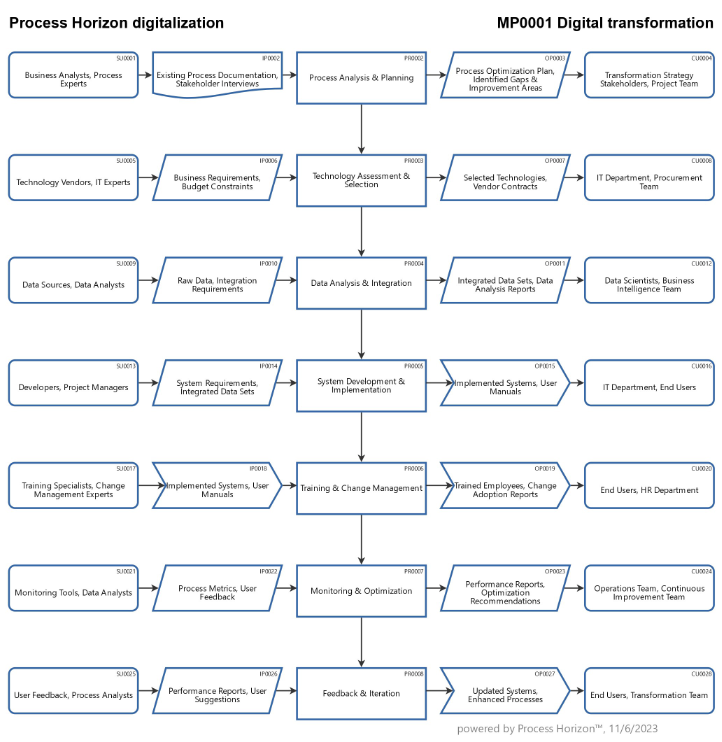Digital transformation process guide

Why is the SIPOC process mapping methodology supported by the ProcessHorizon app key to digitalization and digital transformation ?
Supplier (Source) > Input > PROCESS > Output > Customer (Destination)
- Clarity and Understanding: SIPOC provides a clear and concise visual representation of a process from start to finish. In the context of digitalization, having a deep understanding of existing processes is fundamental. It helps organizations identify bottlenecks, inefficiencies, and areas where digital technologies can be effectively integrated.
- Identifying Stakeholders: In any digital transformation initiative, understanding stakeholders is key. SIPOC helps in identifying who the Suppliers and Customers are, both internally and externally. This knowledge is vital for digital projects because it helps in determining user requirements and expectations.
- Defining Inputs and Outputs: Digitalization often involves automation of tasks and processes. Knowing the specific inputs and outputs of a process is crucial for designing digital systems. Automating the right inputs and outputs streamlines operations, reduces errors and enhances overall efficiency.
- Process Optimization: SIPOC analysis allows organizations to analyze processes step by step. When a process is being digitized, it’s often an opportunity to optimize it. Identifying unnecessary steps or redundancies is easier with a SIPOC process map. This optimization is central to digital transformation as it directly impacts operational efficiency and cost-effectiveness.
- Integration of Digital Technologies: SIPOC process mapping helps organizations identify points in the process where digital technologies like IoT devices, AI, machine learning or data analytics can be integrated. It provides a structured approach to understand where these technologies can be most beneficial and how they can be implemented seamlessly into the existing processes.
- Change Management: Digital transformation involves substantial changes in workflows, roles, and sometimes the entire organizational structure. SIPOC process maps provide a clear understanding of the current state, making it easier to communicate necessary changes to stakeholders. It helps in managing resistance and facilitating a smooth transition to digital processes.
- Continuous Improvement: Digital transformation is not a one-time event; it's an ongoing process. SIPOC process maps serve as a baseline for continuous improvement efforts. By regularly revisiting these process maps, organizations can identify new opportunities for optimization and digital integration, ensuring that they stay competitive in the rapidly changing digital landscape.
Explore the smart ProcessHorizon web app for holistic automated process & data mapping AllinONE: https://processhorizon.com

